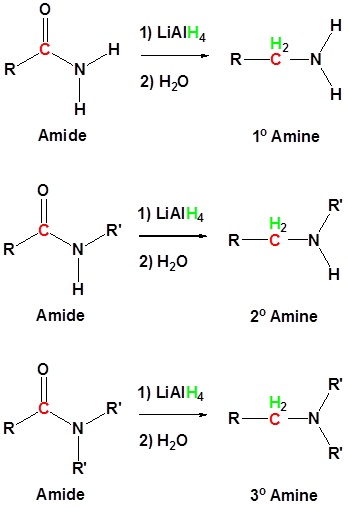24.6 Synthesis of Amines
- Page ID
- 91034
\( \newcommand{\vecs}[1]{\overset { \scriptstyle \rightharpoonup} {\mathbf{#1}} } \)
\( \newcommand{\vecd}[1]{\overset{-\!-\!\rightharpoonup}{\vphantom{a}\smash {#1}}} \)
\( \newcommand{\id}{\mathrm{id}}\) \( \newcommand{\Span}{\mathrm{span}}\)
( \newcommand{\kernel}{\mathrm{null}\,}\) \( \newcommand{\range}{\mathrm{range}\,}\)
\( \newcommand{\RealPart}{\mathrm{Re}}\) \( \newcommand{\ImaginaryPart}{\mathrm{Im}}\)
\( \newcommand{\Argument}{\mathrm{Arg}}\) \( \newcommand{\norm}[1]{\| #1 \|}\)
\( \newcommand{\inner}[2]{\langle #1, #2 \rangle}\)
\( \newcommand{\Span}{\mathrm{span}}\)
\( \newcommand{\id}{\mathrm{id}}\)
\( \newcommand{\Span}{\mathrm{span}}\)
\( \newcommand{\kernel}{\mathrm{null}\,}\)
\( \newcommand{\range}{\mathrm{range}\,}\)
\( \newcommand{\RealPart}{\mathrm{Re}}\)
\( \newcommand{\ImaginaryPart}{\mathrm{Im}}\)
\( \newcommand{\Argument}{\mathrm{Arg}}\)
\( \newcommand{\norm}[1]{\| #1 \|}\)
\( \newcommand{\inner}[2]{\langle #1, #2 \rangle}\)
\( \newcommand{\Span}{\mathrm{span}}\) \( \newcommand{\AA}{\unicode[.8,0]{x212B}}\)
\( \newcommand{\vectorA}[1]{\vec{#1}} % arrow\)
\( \newcommand{\vectorAt}[1]{\vec{\text{#1}}} % arrow\)
\( \newcommand{\vectorB}[1]{\overset { \scriptstyle \rightharpoonup} {\mathbf{#1}} } \)
\( \newcommand{\vectorC}[1]{\textbf{#1}} \)
\( \newcommand{\vectorD}[1]{\overrightarrow{#1}} \)
\( \newcommand{\vectorDt}[1]{\overrightarrow{\text{#1}}} \)
\( \newcommand{\vectE}[1]{\overset{-\!-\!\rightharpoonup}{\vphantom{a}\smash{\mathbf {#1}}}} \)
\( \newcommand{\vecs}[1]{\overset { \scriptstyle \rightharpoonup} {\mathbf{#1}} } \)
\( \newcommand{\vecd}[1]{\overset{-\!-\!\rightharpoonup}{\vphantom{a}\smash {#1}}} \)
\(\newcommand{\avec}{\mathbf a}\) \(\newcommand{\bvec}{\mathbf b}\) \(\newcommand{\cvec}{\mathbf c}\) \(\newcommand{\dvec}{\mathbf d}\) \(\newcommand{\dtil}{\widetilde{\mathbf d}}\) \(\newcommand{\evec}{\mathbf e}\) \(\newcommand{\fvec}{\mathbf f}\) \(\newcommand{\nvec}{\mathbf n}\) \(\newcommand{\pvec}{\mathbf p}\) \(\newcommand{\qvec}{\mathbf q}\) \(\newcommand{\svec}{\mathbf s}\) \(\newcommand{\tvec}{\mathbf t}\) \(\newcommand{\uvec}{\mathbf u}\) \(\newcommand{\vvec}{\mathbf v}\) \(\newcommand{\wvec}{\mathbf w}\) \(\newcommand{\xvec}{\mathbf x}\) \(\newcommand{\yvec}{\mathbf y}\) \(\newcommand{\zvec}{\mathbf z}\) \(\newcommand{\rvec}{\mathbf r}\) \(\newcommand{\mvec}{\mathbf m}\) \(\newcommand{\zerovec}{\mathbf 0}\) \(\newcommand{\onevec}{\mathbf 1}\) \(\newcommand{\real}{\mathbb R}\) \(\newcommand{\twovec}[2]{\left[\begin{array}{r}#1 \\ #2 \end{array}\right]}\) \(\newcommand{\ctwovec}[2]{\left[\begin{array}{c}#1 \\ #2 \end{array}\right]}\) \(\newcommand{\threevec}[3]{\left[\begin{array}{r}#1 \\ #2 \\ #3 \end{array}\right]}\) \(\newcommand{\cthreevec}[3]{\left[\begin{array}{c}#1 \\ #2 \\ #3 \end{array}\right]}\) \(\newcommand{\fourvec}[4]{\left[\begin{array}{r}#1 \\ #2 \\ #3 \\ #4 \end{array}\right]}\) \(\newcommand{\cfourvec}[4]{\left[\begin{array}{c}#1 \\ #2 \\ #3 \\ #4 \end{array}\right]}\) \(\newcommand{\fivevec}[5]{\left[\begin{array}{r}#1 \\ #2 \\ #3 \\ #4 \\ #5 \\ \end{array}\right]}\) \(\newcommand{\cfivevec}[5]{\left[\begin{array}{c}#1 \\ #2 \\ #3 \\ #4 \\ #5 \\ \end{array}\right]}\) \(\newcommand{\mattwo}[4]{\left[\begin{array}{rr}#1 \amp #2 \\ #3 \amp #4 \\ \end{array}\right]}\) \(\newcommand{\laspan}[1]{\text{Span}\{#1\}}\) \(\newcommand{\bcal}{\cal B}\) \(\newcommand{\ccal}{\cal C}\) \(\newcommand{\scal}{\cal S}\) \(\newcommand{\wcal}{\cal W}\) \(\newcommand{\ecal}{\cal E}\) \(\newcommand{\coords}[2]{\left\{#1\right\}_{#2}}\) \(\newcommand{\gray}[1]{\color{gray}{#1}}\) \(\newcommand{\lgray}[1]{\color{lightgray}{#1}}\) \(\newcommand{\rank}{\operatorname{rank}}\) \(\newcommand{\row}{\text{Row}}\) \(\newcommand{\col}{\text{Col}}\) \(\renewcommand{\row}{\text{Row}}\) \(\newcommand{\nul}{\text{Nul}}\) \(\newcommand{\var}{\text{Var}}\) \(\newcommand{\corr}{\text{corr}}\) \(\newcommand{\len}[1]{\left|#1\right|}\) \(\newcommand{\bbar}{\overline{\bvec}}\) \(\newcommand{\bhat}{\widehat{\bvec}}\) \(\newcommand{\bperp}{\bvec^\perp}\) \(\newcommand{\xhat}{\widehat{\xvec}}\) \(\newcommand{\vhat}{\widehat{\vvec}}\) \(\newcommand{\uhat}{\widehat{\uvec}}\) \(\newcommand{\what}{\widehat{\wvec}}\) \(\newcommand{\Sighat}{\widehat{\Sigma}}\) \(\newcommand{\lt}{<}\) \(\newcommand{\gt}{>}\) \(\newcommand{\amp}{&}\) \(\definecolor{fillinmathshade}{gray}{0.9}\)Objectives
After completing this section, you should be able to
- write equations to illustrate the synthesis of amines by
- reduction of nitriles or amides and nitro compounds.
- reactions involving alkyl groups:
- SN2 reactions of alkyl halides, ammonia and other amines.
- nucleophilic attack by an azide ion on an alkyl halide, followed by reduction of the azide so formed.
- alkylation of potassium phthalimide, followed by hydrolysis of the N‑alkyl phthalimide so formed (i.e., the Gabriel synthesis).
- reductive amination of aldehydes or ketones.
- Hofmann or Curtius rearrangements.
- write detailed mechanisms for each of the steps involved in the synthetic routes outlined in Objective 1.
- identify the product or products formed when
- a given nitrile or amide is reduced using lithium aluminum hydride.
- a given alkyl halide is reacted with ammonia or an alkylamine.
- a given alkyl halide is reacted with azide ion and the resulting product is reduced.
- a given alkyl halide is reacted with potassium phthalimide and the resulting product is hydrolyzed.
- a given aldehyde or ketone is reacted with ammonia or an amine in the presence of nickel catalyst.
- a given amide is treated with halogen and base.
- a given acyl azide is heated and then hydrolyzed.
- identify the starting material, the other reagents, or both, needed to synthesize a given amine by any of the routes listed in Objective 1.
- write a general equation to illustrate the preparation of an arylamine by the reduction of a nitro compound, and balance such an equation.
- identify the product formed from the reduction of a given aromatic nitro compound.
- identify the organic compound, the inorganic reagents, or both, needed to prepare a given arylamine.
Make certain that you can define, and use in context, the key terms below.
- azide synthesis
- Curtius rearrangement
- Hofmann rearrangement
- Gabriel synthesis
- imide
- reductive amination
You may wish to review the mechanism of SN2 reactions which is discussed in some detail in Sections 11.2 and 11.3.
Azide synthesis is the first method on the table of synthesis of primary amines. The Lewis structure of the azide ion, N3−, is as shown below.

An “imide” is a compound in which an N$\ce{-}$H group is attached to two carbonyl groups; that is,

You should note the commonly used trivial names of the following compounds.
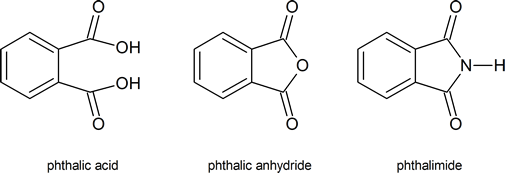
The phthalimide alkylation mentioned in the reading is also known as the Gabriel synthesis.
If necessary, review the reduction of nitriles (Section 20.7) and the reduction of amides (Section 21.7).
Before you read the section on reductive amination you may wish to remind yourself of the structure of an imine (see Section 19.8).
The Hofmann rearrangement is usually called the Hofmann degradation. In a true rearrangement reaction, no atoms are lost or gained; however, in this particular reaction one atom of carbon and one atom of oxygen are lost from the amide starting material, thus the term “rearrangement” is not really appropriate. There is a rearrangement step in the overall degradation process, however: this is the step in which the alkyl group of the acyl nitrene migrates from carbon to nitrogen to produce an isocyanate.
You get a complicated series of reactions on heating primary amines with halogenoalkanes to give a mixture of products - probably one of the most confusing sets of reactions you will meet at this level. The products of the reactions include secondary and tertiary amines and their salts, and quaternary ammonium salts.
Making secondary amines and their salts
In the first stage of the reaction, you get the salt of a secondary amine formed. For example if you started with ethylamine and bromoethane, you would get diethylammonium bromide

In the presence of excess ethylamine in the mixture, there is the possibility of a reversible reaction. The ethylamine removes a hydrogen from the diethylammonium ion to give free diethylamine - a secondary amine.

Making tertiary amines and their salts
But it doesn't stop here! The diethylamine also reacts with bromoethane - in the same two stages as before. This is where the reaction would start if you reacted a secondary amine with a halogenoalkane.
In the first stage, you get triethylammonium bromide.

There is again the possibility of a reversible reaction between this salt and excess ethylamine in the mixture.

The ethylamine removes a hydrogen ion from the triethylammonium ion to leave a tertiary amine - triethylamine.
Making a quaternary ammonium salt
The final stage! The triethylamine reacts with bromoethane to give tetraethylammonium bromide - a quaternary ammonium salt (one in which all four hydrogens have been replaced by alkyl groups).

This time there isn't any hydrogen left on the nitrogen to be removed. The reaction stops here.
Preparation of Primary Amines
Although direct alkylation of ammonia by alkyl halides leads to 1º-amines, alternative procedures are preferred in many cases. These methods require two steps, but they provide pure product, usually in good yield. The general strategy is to first form a carbon-nitrogen bond by reacting a nitrogen nucleophile with a carbon electrophile. The following table lists several general examples of this strategy in the rough order of decreasing nucleophilicity of the nitrogen reagent. In the second step, extraneous nitrogen substituents that may have facilitated this bonding are removed to give the amine product.
|
Nitrogen |
Carbon |
1st Reaction |
Initial Product |
2nd Reaction |
2nd Reaction |
Final Product |
|---|---|---|---|---|---|---|
| N3(–) | RCH2-X or R2CH-X |
SN2 | RCH2-N3 or R2CH-N3 |
LiAlH4 or 4 H2 & Pd |
Hydrogenolysis | RCH2-NH2 or R2CH-NH2 |
| C6H5SO2NH(–) | RCH2-X or R2CH-X |
SN2 | RCH2-NHSO2C6H5 or R2CH-NHSO2C6H5 |
Na in NH3 (liq) | Hydrogenolysis | RCH2-NH2 or R2CH-NH2 |
| CN(–) | RCH2-X or R2CH-X |
SN2 | RCH2-CN or R2CH-CN |
LiAlH4 | Reduction | RCH2-CH2NH2 or R2CH-CH2NH2 |
| NH3 | RCH=O or R2C=O |
Addition / Elimination |
RCH=NH or R2C=NH |
H2 & Ni or NaBH3CN |
Reduction | RCH2-NH2 or R2CH-NH2 |
| NH3 | RCOX | Addition / Elimination |
RCO-NH2 | LiAlH4 | Reduction | RCH2-NH2 |
| NH2CONH2 (urea) |
R3C(+) | SN1 | R3C-NHCONH2 | NaOH soln. | Hydrolysis | R3C-NH2 |
A specific example of each general class is provided in the diagram below. In the first two, an anionic nitrogen species undergoes an SN2 reaction with a modestly electrophilic alkyl halide reactant. For example #2 an acidic phthalimide derivative of ammonia has been substituted for the sulfonamide analog listed in the table. The principle is the same for the two cases, as will be noted later. Example #3 is similar in nature, but extends the carbon system by a methylene group (CH2). In all three of these methods 3º-alkyl halides cannot be used because the major reaction path is an E2 elimination.
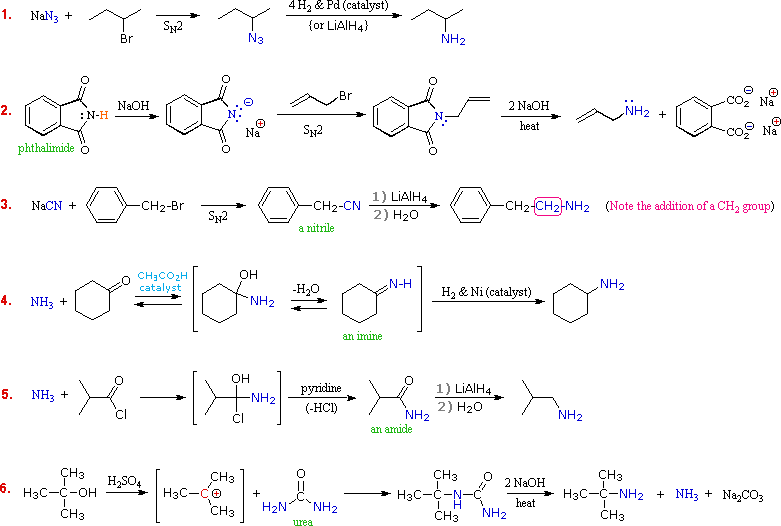
The methods illustrated by examples #4 and #5 proceed by attack of ammonia, or equivalent nitrogen nucleophiles, at the electrophilic carbon of a carbonyl group. A full discussion of carbonyl chemistry is presented later, but for present purposes it is sufficient to recognize that the C=O double bond is polarized so that the carbon atom is electrophilic. Nucleophile addition to aldehydes and ketones is often catalyzed by acids. Acid halides and anhydrides are even more electrophilic, and do not normally require catalysts to react with nucleophiles. The reaction of ammonia with aldehydes or ketones occurs by a reversible addition-elimination pathway to give imines (compounds having a C=N function). These intermediates are not usually isolated, but are reduced as they are formed (i.e. in situ). Acid chlorides react with ammonia to give amides, also by an addition-elimination path, and these are reduced to amines by LiAlH4.
The 6th example is a specialized procedure for bonding an amino group to a 3º-alkyl group (none of the previous methods accomplishes this). Since a carbocation is the electrophilic species, rather poorly nucleophilic nitrogen reactants can be used. Urea, the diamide of carbonic acid, fits this requirement nicely. The resulting 3º-alkyl-substituted urea is then hydrolyzed to give the amine. One important method of preparing 1º-amines, especially aryl amines, uses a reverse strategy. Here a strongly electrophilic nitrogen species (NO2(+)) bonds to a nucleophilic carbon compound. This nitration reaction gives a nitro group that can be reduced to a 1º-amine by any of several reduction procedures.
The Hofmann rearrangement of 1º-amides provides an additional synthesis of 1º-amines.
Reduction of Other Functional Groups that Contain Nitrogen
Reduction of Nitro Groups
Several methods for reducing nitro groups to amines are known. These include catalytic hydrogenation (H2 + catalyst), zinc or tin in dilute mineral acid, and sodium sulfide in ammonium hydroxide solution. The procedures described above are sufficient for most case
Nitriles can be converted to 1° amines by reaction with LiAlH4
During this reaction the hydride nucleophile attacks the electrophilic carbon in the nitrile to form an imine anion. Once stabilized by a Lewis acid-base complexation the imine salt can accept a second hydride to form a dianion. The dianion can then be converted to an amine by addition of water.
Amides can be converted to 1°, 2° or 3° amines using LiAlH4
Reductive Amination
Aldehydes and ketones can be converted into 1o, 2o and 3o amines using reductive amination. The reaction takes place in two parts. The first step is the nucleophiic addition of the carbonyl group to form an imine. The second step is the reduction of the imine to an amine using an reducing agent. A reducing agent commonly used for this reaction is sodium cyanoborohydride (NaBH3CN).
Planning a Synthesis using a Reductive Amination
If you are trying to develop a synthesis of an amine molecule, the key bond break is a C-N bond in the target molecule. There may be multiple C-N bonds present, so each should be broken separately to produce a possible set of starting materials. Because the amine is commonly used in excess during a reductive animation, the pathway which provides the simplest amine starting material is preferred. The carbon from the broken C-N bond goes on to become a carbonyl starting material. The nitrogen gains a hydrogen to become the amine starting material.

Show how N-methylbenzylamine can be synthesized using a reductive amination. If more than one pathway is possible, draw them both and determine which one would be preferred.
- Answer
-
Pathway 1

Solution 1
Pathway 2

Solution 2
Because N-methylbenzylamine has two C-N bonds there are two possible synthesis pathways. Pathway 1 is most likely preferred because it uses the simplest amine starting material, methyl amine.
Hofmann rearrangement
Hofmann rearrangement, also known as Hofmann degradation and not to be confused with Hofmann elimination, is the reaction of a primary amide with a halogen (chlorine or bromine) in strongly basic (sodium or potassium hydroxide) aqueous medium, which converts the amide to a primary amine. For example:

Mechanism:
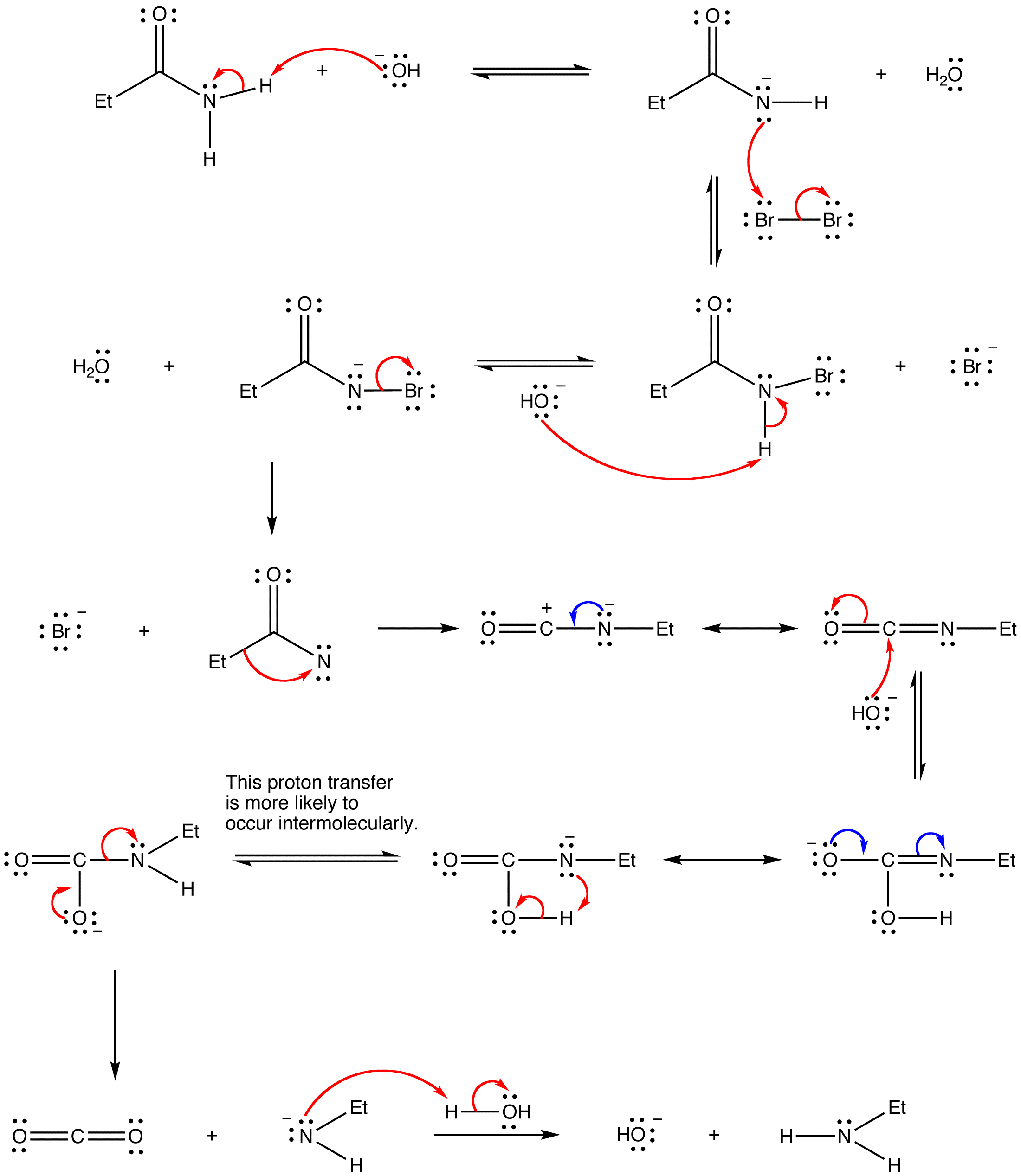
Curtius Rearrangement
The Curtius rearrangement involves an acyl azide.
The mechanism of the Curtius rearrangement involves the migration of an -R group form the carbonyl carbon to the the neighboring nitrogen.
Planning a Synthesis using a Hofman or Curtius Rearrangement
Because the amide and the acyl azide required for these rearrangements both are best made from an acid chloride, synthesis of amines using these reaction are best started from the corresponding carboxylic acid. For retrosynthetic analysis starting from the desired amine product - the key break is the C-NH2 bond. The amine is removed and replaced with a -CO2H fragment to provide the required carboxylic acid starting material.

Show how the following molecule could be prepared from a carboxylic acid starting material using both the Hoffman and Curtius rearrangements.
- Answer
-
First determine the structure of the carboxylic acid starting material. This will be the starting material for both rearrangements. In the first step, convert the carboxylic acid into an acid halide using thionyl chloride (SOCl2). Then use the required conditions for each rearrangement.

Solution
The top solution shows the Curtius Rearrangement, while the bottom is an example using the Hofmann Rearrangement.

Exercises
Propose structures of the starting materials needed to make the the following amines using the reduction of a nitrile or an amide:
a) CH3CH2CH2CH2NH2
b) (CH3CH2)2NH
c)

e) N-Propylaniline
- Answer
-
a) CH3CH2CH2CONH2
b) CH3CONHCH2CH3
c)
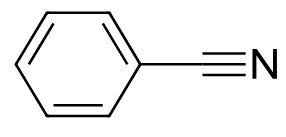
e)
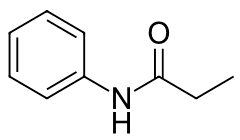
1) Write the mechanism for the base promoted hydrolysis of an N-alkyl phthalimide to create a 1o amine and the phthalate ion.
2) Starting with any alkyl halide, show two methods to synthesize the neurotransmitter serotonin.
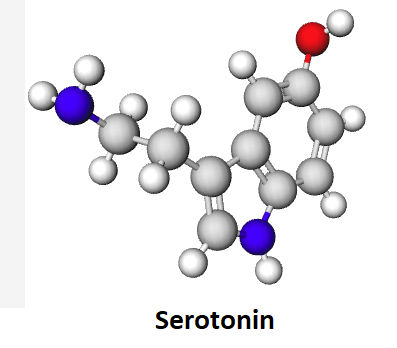
- Answers
-
1)
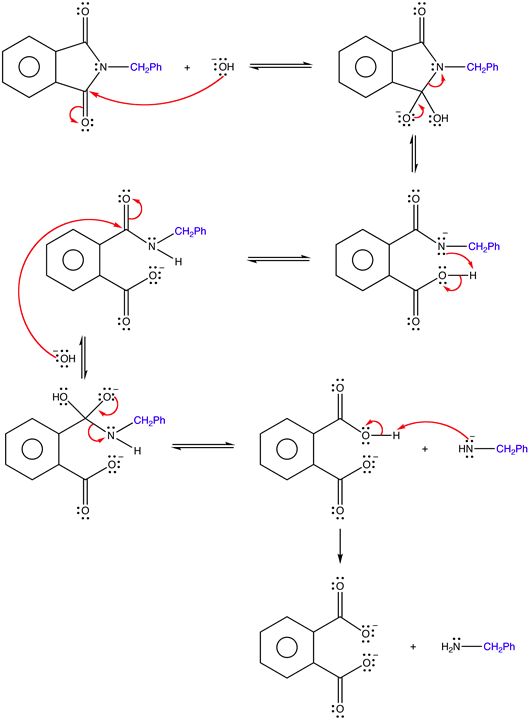
2)


Provide starting materials which could be used to prepare the following compounds using a reductive amination. Show all possible pathways.
1)
a)
b)
c)
2) Please give the starting materials which could provide the following molecule using a reductive amination.

- Answer
-
1)
a)
b)
c)
2)
1) Using a carboxylic acid starting material explain how to prepare the following molecules using both the Hoffman and Curtius rearrangements.
a)
b)
- Answers
-
1)
a) The top solution shows the Curtius Rearrangement, while the bottom is an example using the Hofmann Rearrangement.
b) The top solution shows the Curtius Rearrangement, while the bottom is an example using the Hofmann Rearrangement.
Contributors and Attributions
Dr. Dietmar Kennepohl FCIC (Professor of Chemistry, Athabasca University)
Prof. Steven Farmer (Sonoma State University)
William Reusch, Professor Emeritus (Michigan State U.), Virtual Textbook of Organic Chemistry
Organic Chemistry With a Biological Emphasis by Tim Soderberg (University of Minnesota, Morris)
Jim Clark (Chemguide.co.uk)
- Gamini Gunawardena from the OChemPal site (Utah Valley University)



